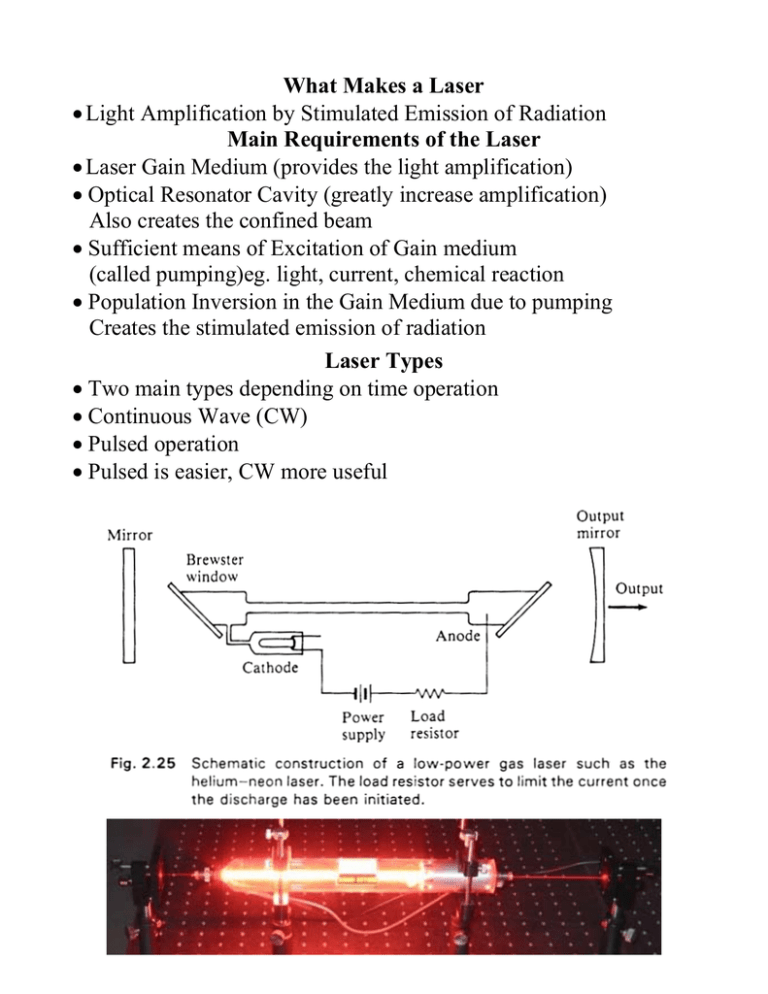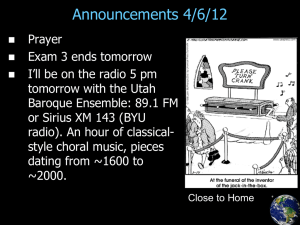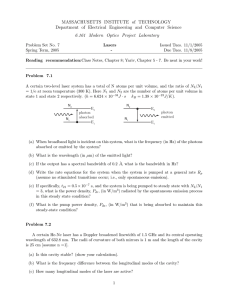What Makes a Laser • Light Amplification by Stimulated Emission of
advertisement

What Makes a Laser • Light Amplification by Stimulated Emission of Radiation Main Requirements of the Laser • Laser Gain Medium (provides the light amplification) • Optical Resonator Cavity (greatly increase amplification) Also creates the confined beam • Sufficient means of Excitation of Gain medium (called pumping)eg. light, current, chemical reaction • Population Inversion in the Gain Medium due to pumping Creates the stimulated emission of radiation Laser Types • Two main types depending on time operation • Continuous Wave (CW) • Pulsed operation • Pulsed is easier, CW more useful Regular Light Sources: Equilibrium Energy Populations • Laser are quantum devices • Assume gas in thermal equilibrium at temperature T • Some atoms in a Gas are in an excited state • Quantization means discrete energy levels • Initially Ni Atoms (atoms/m3) at a given ith energy level Ei • E0 is the ground state (unexcited) • Under steady state thermal most at lowest energy levels • Fraction at a given energy follows a Boltzmann distribution Ni ⎛ [E − E0 ] ⎞ = exp⎜ − i ⎟ KT N0 ⎠ ⎝ T = degrees K K = Boltzman constant 1.38 x 10-23 J/K = 8.62 x 10-5 eV/K • Boltzman distribution is what creates the Black body emission Spontaneous and Stimulated Emission • Consider 2 energy levels E0 (ground state) and E1 (excited state) • Photon can cause Stimulated Absorption E0 to E1 • Excited state has some finite lifetime, τ10 (average time to change from state 1 to state 0) • Spontaneous Emission of photon when transition occurs • Randomly emitted photons when change back to level 0 • Passing photon of same λ can cause "Stimulated Emission" • Stimulated photon is emitted in phase with causal photon • Einstein proposed this in 1916 • Stimulated emission the foundation of laser operation Einstein's Rate Equations • Between energy levels 2 and 1 the rate of change from 2 to 1 is dN 21 = − A21 N 2 dt • where A21 is the Einstein Coefficient (s-1) • After long time energy follows a Boltzmann distribution N2 ⎛ [E − E1 ] ⎞ = exp⎜ − 2 ⎟ KT ⎠ N1 ⎝ • If (E2 - E1) >> KT then over a long time N 2 ( t ) = N 2 ( 0 ) exp( A21t ) • Thus in terms of the lifetime of the level τ21 sec, 1 A21 = τ 21 • illuminated by light of energy density ρ = nhν (J/m3) (n= number of photons/m3) of frequency ν12 the absorption is • At frequency ν12 the absorption is dN 1 = N 1 B12 ρ (ν 12 ) emissions 3 m s dt • B12 is the Einstein absorption coefficient (from 1 to 2) • Similarly stimulated emission rate (with B21=B12) is dN 2 = N 2 B21 ρ (ν 21 ) emissions 3 ms dt Two level system: Population Inversion • In thermal equilibrium lower level always greater population • N1 >> N2 • Can suddenly inject energy into system - pumping • Now not a equilibrium condition • If pumped hard enough get "Population Inversion" • Upper level greater than lower level: N2 >> N1 • Population Inversion is the foundation of laser operation Creates the condition for high stimulated emission • In practice difficult to get 2 level population inversion • Best pumping with light gives is equal levels • Reason is Einstein’s rate equations dN 2 dN 1 = N 2 B21 ρ (ν 21 ) = N 1 B12 ρ (ν 21 ) = dt dt emissions • Since B21=B12 then N1=N2 with light pumping • Need more levels to get population inversion m3 s Three level systems • Pump to E0 level E2, but require E2 to have short lifetime • Rapid decay to E1 • E1 must have very long lifetime: called Metastable • Now population inversion readily obtained with enough pumping • Always small amount of spontaneous emission (E1 to E0) • Spontaneous create additional stimulated emission to E0 • If population inversion: stimulated emission dominates: Lasing • Common example Ruby (1st laser) and Nd:Yag laser • Problem: E0 often very full He-Ne Laser Energy levels • He-Ne laser is example of 3 level laser • Levels are created in both He and Ne atoms • Fast decay from lower state (2p) to ground state • First laser (Ruby) was a 3 level system Four Level Systems • Pump to level E3, but require E3 to have short lifetime • Rapid decay to E2 so E3 is always empty • E2 must have very long lifetime: metastable so fills up • Also require E1 short lifetime for decay to E0 • Now always have E1 empty relative to E2 • In principal easier for population inversion but lowers efficiency • Always small amount of spontaneous emission (E2 to E1) • Spontaneous photons create additional stimulated emission to E1 • If population inversion: stimulated emission dominates • Problem: low efficiency: energy losses at E3 to E2 and E1 to E0 • Example Carbon Dioxide laser (very efficient) Absorption in Homogeneous Mediums • Monochromatic beam passing through absorbing medium homogeneous medium • Change in light intensity I is ΔI = I ( x + Δx ) − I (x) ΔI = −αΔxI (x) where α = the absorption coefficient (cm-1) • In differential form dI ( x) = −αI ( x) dx • This differential equation solves as I ( x) = I 0 exp(−αx) Gain in Homogeneous Mediums • If we have a population inversion increase I • Stimulated emission adds to light: gain I ( x) = I 0 exp( gx) g = small signal gain coefficient (cm-1) • In practice get both absorption and gain I ( x) = I 0 exp([g − a ]x) • Gain is related directly to the population inversion g = g 0 ( N1 − N 0 ) g0 = a constant for a given system • This seen in the Einstein B Coefficients • Thus laser needs gain medium to amplify signal Optical Resonator Cavity • In laser want to confine light: have it bounce back and forth • Then it will gain most energy from gain medium • Need several passes to obtain maximum energy from gain medium • Confine light between two mirrors (Resonator Cavity) Also called Fabry Perot Etalon • Have mirror (M1) at back end highly reflective • Front end (M2) not fully transparent • Place pumped medium between two mirrors: in a resonator • Needs very careful alignment of the mirrors (arc seconds) • Only small error and cavity will not resonate • Curved mirror will focus beam approximately at radius • However is the resonator stable? • Stability given by g parameters: g1 back mirror, g2 front mirror: gi = 1 − L ri • For two mirrors resonator stable if 0 < g1 g 2 < 1 • Unstable if g1 g 2 < 0 g1 g 2 > 1 • At the boundary (g1g2 = 0 or 1) marginally stable Stability of Different Resonators • If plot g1 vs g2 and 0 < g1 g 2 < 1 then get a stability plot • Now convert the g’s also into the mirror shapes Polarization and Lasers • Lasers often need output windows on gain medium in cavity • Output windows often produce polarized light • Normal windows lose light to reflection • Least loss for windows if light hits glass at Brewster Angle • Perpendicular polarization reflected • Parallel polarization transmitted with no loss (laser more efficient) • Called a Brewster Window & the Brewster Angle is ⎛n ⎞ θ b = tan −1 ⎜⎜ 2 ⎟⎟ ⎝ n1 ⎠ n1 = index of refraction of air n2 = index of refraction of glass • Example: What is Brewster for Glass of n2 = 1.5 ⎛ n2 ⎞ ⎛ 1 .5 ⎞ o ⎟⎟ = tan −1 ⎜ ⎟ = 56.6 ⎝ 1 ⎠ ⎝ n1 ⎠ θ b = tan −1 ⎜⎜ Gain Medium & Laser Threshold • With good Gain Medium in optical cavity can get lasing but only if gain medium is excited enough • Low pumping levels: mostly spontaneous emission • At some pumping get population inversion in gain medium • Beyond inversion get Threshold pumping for lasing set by the losses in cavity • Very sensitive to laser cavity condition eg slight misalignment of mirrors threshold rises significantly • At threshold gain in one pass = losses in cavity Round Trip Power Gain • Within medium light intensity I gained in one pass I ( L ) = I 0 exp[( g − α )L ] where g = small signal gain coefficient α = the absorption coefficient L = length of cavity • Thus calculate Round Trip Power Gain Gr • Each mirror has a reflectivity Ri R=1 for perfect reflection off a mirror Gr = I( 2L ) = R1 R2 exp[( g − α )2 L ] I( 0 ) • At threshold Gr = 1 • Thus threshold gain required for lasing is gth = α + 1 ⎛ 1 ⎞ ⎟⎟ ln⎜⎜ 2 L ⎝ R1 R2 ⎠ • Some of the loss = laser emission Transition Line Shape • Distribution of energy levels creates width of emission • Usually Gaussian shape • Width broadened by many mechanisms • Most more important in gases • Doppler Broadening (movement of molecules) • Collision Broadening (atomic/molecular collisions) • Radiative Lifetime Broadening (finite lifetime of transitions) Axial Modes of Laser • Proper phase relationship only signal in phase in cavity • Thus cavity must be integer number of half wavelengths L= pλ 2 where p = integer • Results in frequency separation of peaks c 2L • Emission from the atomic transitions is a wider Gaussian • Result is axial modes imposed on Gaussian Transition spread Δν = Axial modes within Transition Gaussian • Each axial mode is Gaussian shape narrower than transition peak • eg for L=1 m Argon laser at 514 nm c 3.00 x10 8 c 3.00 x10 8 Δν = = = 150 MHz ν = = = 5.83 x1014 Hz −7 2L 2 λ 5.14 x10 • Thus emission much smaller than 0.0026% of frequency Much narrower than other light sources. Transverse Modes • Comes from microwave cavities • Some waves travel off axis, but within cavity • Result is Phase changes in repeating paths • These can change shape of output • Get local minimums (nulls) in the output beam shape • Reduce these by narrowing the beam • Called Transverse ElectroMagnetic, TEM Transverse Modes • Transverse ElectroMagnetic, TEM depend on cavity type • In cylindrical geometry two possible phase reversal orientations • horizontal (q) and vertical (r) • Show these as TEMqr • q and r give number of null's in output beam • Horizontal (q) gives number of vertical running nulls • Vertical (r) gives number of horizontal running nulls • Thus TEM12 has 2 vertical, 1 horizontal nulls • Special mode TEM01* or donut mode • comes from rapid switching from TEM01 to TEM10 Einstein Coefficients and Lasers • Recall the Einstein Emission/Absorption Coefficients • Consider again a 2 level system being pumped by light • A21 is the Einstein spontaneous emission Coefficient • B12 is the Einstein spontaneous absorption coefficient • B21 is the Einstein stimulated emission coefficient • At equilibrium the absorption from pumping equals the spontaneous and stimulated emission. N1 ρB12 = N 2 A21 + N 2 ρB21 • Now recall the Boltzman distribution N1 ⎛ hν ⎞ ⎛ [E − E0 ] ⎞ = exp⎜ 1 ⎟ ⎟ = exp⎜ N0 ⎝ KT ⎠ ⎝ KT ⎠ • ν = the frequency of the light • hν = energy in photon • Thus hν ⎞ ⎟ = A21 + ρB21 KT ⎝ ⎠ ρB12 exp⎛⎜ Einstein Coefficients relationships • Solving for the emitted photon energy density ρ= A21 ⎛ hν ⎞ B12 exp ⎜ ⎟ − B21 ⎝ KT ⎠ • From Planck's law the photons emitted at a given temperature are: 8π hν 3 ρ= ⎡ ⎛ hν ⎞ ⎤ c 3 ⎢exp⎜ ⎟ − 1⎥ ⎣ ⎝ KT ⎠ ⎦ • From these two can solve noting B12 = B21 8π hν 3 8π h A21 = B = B 12 c3 λ3 12 • Note absorption to emission increases rapidly with wavelength Under Lasing Conditions • Spontaneous emission is nil so total emission/unit area is dI = ( N 2 − N1 )B21 ρhν dx • For a linear beam I = ρ c (energy density times speed) thus dI ( N 2 − N1 )B21hνI = dx c • Thus the gain is g= ( N 2 − N1 )B21hν c • Or substituting for the spontaneous coefficient ( N 2 − N1 ) A21c 2 ( N 2 − N1 )λ2 g= = 8πν 2 8πτ 21 • Three important implications because we need g>gth to lase (1) For gain N2>N1 (i.e. population inversion) (2) Shorter wavelength the lower the gain Hence much harder to make UV than IR lasers (3) Want short lifetime τ21 for higher gain • But want metastable long τ21 to get population inversion! • Hence tradeoff: τ21 must be short enough for threshold g but long enough for population inversion • More difficult to achieve for CW (continuous) lasers

